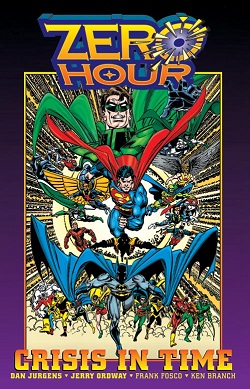Zero Hour: Crisis in Time
| Zero Hour: Crisis in Time! | |
|---|---|

Cover of Zero Hour: Crisis in Time trade paperback.
Art by Dan Jurgens. |
|
| Publication information | |
| Publisher | DC Comics |
| Schedule | Weekly |
| Format | Limited series |
| Publication date | September 1994 |
| Number of issues | 5 |
| Main character(s) | DC Universe |
| Creative team | |
| Writer(s) | Dan Jurgens |
| Penciller(s) | Dan Jurgens |
| Inker(s) | Jerry Ordway |
| Letterer(s) | Gaspar Saladino |
| Colorist(s) | Gregory Wright |
| Creator(s) | Dan Jurgens Jerry Ordway |
| Editor(s) | K.C. Carlson |
| Collected editions | |
| Zero Hour: Crisis in Time | |
"Zero Hour: Crisis in Time!" is a comic book crossover storyline published by DC Comics in 1994, consisting of an eponymous five-issue central miniseries and a number of tie-in books. In it, the former hero Hal Jordan, who had until then been a member of the intergalactic police force known as the Green Lantern Corps, mad with grief after the destruction of his home town of Coast City (during the "Reign of the Supermen!" storyline) and having obtained immense power as Parallax, attempted to destroy, and then remake, the DC Universe. The crossover involved almost every DC Universe monthly series published at the time. The issues of the series itself were numbered in reverse order, beginning with issue #4 and ending with #0 (i.e., Counting Down To Zero). The series was written and penciled by Dan Jurgens, with inks by Jerry Ordway. This series is noted for its motif of the DC Universe gradually "fading out" as events reached their climax.
Zero Hour: Crisis in Time! was intended by DC as a belated follow-up to their landmark limited series Crisis on Infinite Earths, and was indeed subtitled "(A) Crisis in Time!". It promised to do for the inconsistent future timelines of the DC Universe what Crisis had done for its parallel worlds: unify them into a new one.
This event served as an opportunity to reconcile some of the problems left unaddressed by Crisis and other problems that had been unintentionally caused by it. In particular, the revised characters of the post-Crisis universe had been rolled out gradually, with DC continuing to feature the old versions until the new versions were launched, some of them a year or several after the first wave of revised characters were published (i.e., The Man of Steel, Wonder Woman vol. 2, Batman: Year One). The character of Hawkman was one of the most problematic, since the revised version did not first appear until 1989. This raised the question of what version of Hawkman had been seen since 1986 (he had been retconned to be both the Golden Age Hawkman and a Thanagarian spy). The Legion of Super-Heroes faced similar problems with the eliminations of Superboy and Supergirl from DC continuity (Mon-El, a character with similar powers, had been recast as Valor to take Superboy's place as the Legion's inspiration and most powerful member). These and other retcons were not always well received by readers and often introduced new problems.
...
Wikipedia
